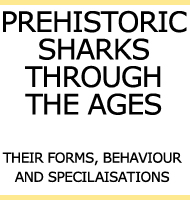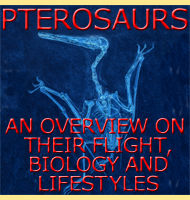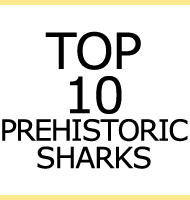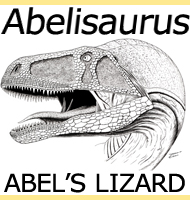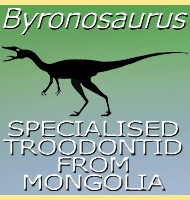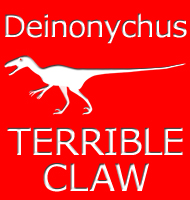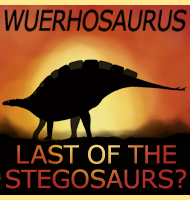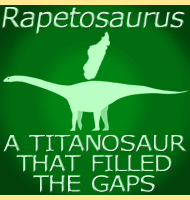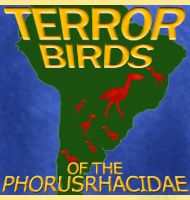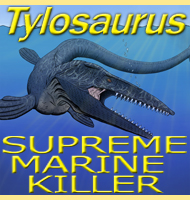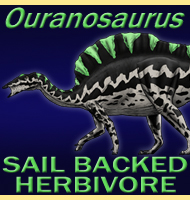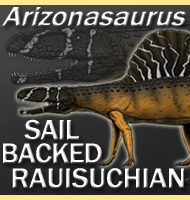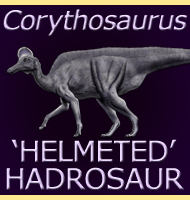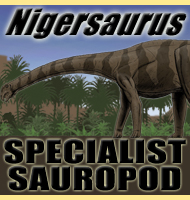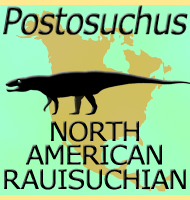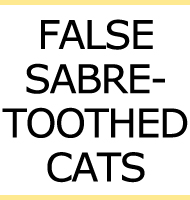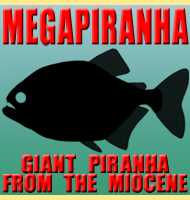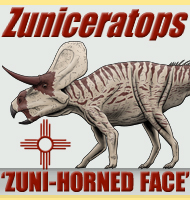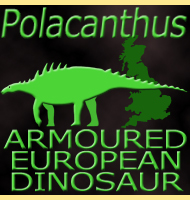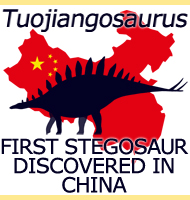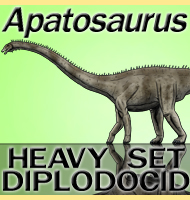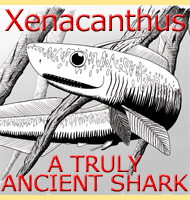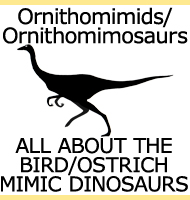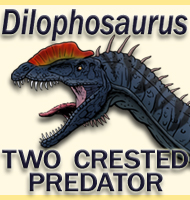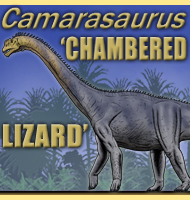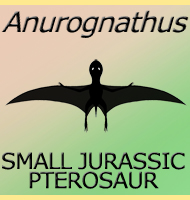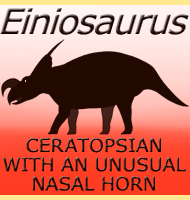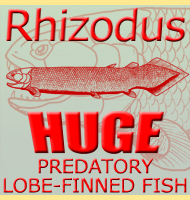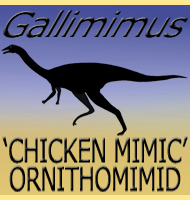


THE TYRANNOSAURS
Dinosaur Predators of the Tyrannosauroidea
and the Tyrannosauridae
Say Tyrannosaurus rex and everyone knows what you are talking about, but say Guanlong or Alioramus and you might be met with a blank stare. The tyrannosaurs were amongst the last and most specialised of the theropod groups, and they can be roughly divided into two further groups. The most primitive members of the group were the tyrannosauroids (members assigned to just the more general Tyrannosauroidea) and looking here we can see how the tyrannosaurs began to evolve into the dominant predators of the northern hemisphere during the Cretaceous. By the end of the Cretaceous the tyrannosaurids held domain over the landscape. Tyrannosaurids can still be called tyrannosauroids since they still belong to this group, but they can be further separated into their own group (the Tyrannosauridae, which itself includes a further sub group called the Tyrannosaurinae) unique from the other tyrannosauroids. These members represent the pinnacle of tyrannosauroid evolution that began at least as far back as the Jurassic, and which was only cut short by the mass extinction of the dinosaurs at the end of the Mesozoic.
Where did the tyrannosaurs come
from?
The
first tyrannosaurs to be discovered were the larger members of the
Tyrannosauridae that lived in the final stages of the Cretaceous.
However, to get a better understanding of the tyrannosaurs as a
larger group you need to go all the way back to the early Cretaceous
and even late Jurassic where the earliest members of the
Tyrannosauroidea are currently known from.
In
the early days of tyrannosaur study the tyrannosaurs were usually
assumed to be later relatives of dinosaurs such as large theropods like
Allosaurus.
The reasoning was simple, large theropods alive in the
late Cretaceous must be descended from large theropods of the late
Jurassic because they were both the largest predators in their
ecosystems of the times. Not all palaeontologists agreed with this
idea though, and with the advent of new discoveries and more in depth
analysis of specimens, the conclusion that tyrannosaurs were later
descendants of carnosaurs like Allosaurus is now
confirmed as wrong.
This
discovery centres around the idea that tyrannosaurs were actually an
evolutionary offshoot of the coelurosaurs, smaller predatory
theropods that were around at the same time as carnosaurs like
Allosaurus, but not directly related to them other
than the fact that
both groups are both tetanuran (stiff tailed) theropods. The link
was first proposed when similarities between coelurosaurs and
tyrannosaurs were noted in the formation of certain bones of the
skeleton. While carnosaurs were the dominant theropod predators of
the Jurassic, the coelurosaurs were active predators in their own
right, but in an ecological niche that saw them hunting only smaller
prey, while staying out of the predatory scope of larger theropods.
A
lineage between the tyrannosaurs and the coelurosaurs really started to
be pieced together in the early years of the twenty-first century.
In 2001 an early Cretaceous tyrannosuroid from England named
Eotyrannus
gave a glimpse at early tyrannosaur body forms. Although
built like a tyrannosaur, Eotyrannus had much
longer arms and hands
than later tyrannosaurs of the Tyrannosauridae, as well as three
fingered hands and proportionately longer legs. So, while the body
was on the way to being like a tyrannosaur, the limbs were more in
proportion with the earlier coelurosaurs.
Three
years later in 2004 the description of Dilong
from China was
published. Also dating from the early Cretaceous, Dilong
also has
long limb proportions and an estimated body size of around two metres
long when adult (the holotype is of a smaller juvenile), more in
keeping with coelurosaur sizes. Dilong
also had three fingered hands
further confirming its primitive place in tyrannosaur evolution.
Interestingly though the upper bones in the snout of Dilong
are fused
together, a trait associated with the later and much tyrannosaurids.
Two
years after this in 2006 yet another primitive tyrannosauroid from
China was named; Guanlong.
A little larger than Dilong and with a
fancy looking crest on its snout, Guanlong pushed
the boundaries of
tyrannosaur evolution all the way back into the Oxfordian stage of the
Jurassic forming a line that now joins the coelurosaurs of the Jurassic
to the tyrannosaurids of the late Cretaceous. At the time of its
description Guanlong was widely reported the world
over as the oldest
known tyrannosaur (as a member of the Tyrannosauroidea as opposed to
the Tyrannosauridae) but there is now some controversy as to what is
exactly the oldest known tyrannosauroid.
Back
in 1926 the palaeontologist Friedrich Von Huene named
Proceratosaurus
(from remains that were originally described as a
species of Megalosaurus
in 1910). The name means ‘first horned
lizard’, a reference to the fact that it had a nasal horn and lived
before the more famous Ceratosaurus.
Proceratosaurus was considered
to be a coelurosaur but from the late twentieth to early twenty-first
century it has been considered by some to be a basal tyrannosauroid.
Others however insist that Proceratosaurus is not
a tyrannosauroid and
is a coelurosaur, though so far it cannot be clearly defined as one
either, or at least not as well as some better known coelurosaur
genera. A possible third option is that Proceratosaurus
might be part
of an evolutionary offshoot that began to diverge away from the
coelurosaur form but otherwise remained separate from the
tyrannosaurs.
There
is now sufficient evidence to state that the tyrannosaurs evolved from
the coelurosaurs, but what about the tyrannosaurids at the end of the
Cretaceous? The tyrannosauroids diverged away from the coelruosaurs
in the late Jurassic and by the early Cretaceous they had already grown
to medium theropod sizes. In 2012 the description of Yutyrannus
revealed that some tyrannosauroids in the early Cretaceous were already
approaching nine meters long, though this was still smaller than
other theropod types of the time such as carcharodontosaurs
(i.e.
Acrocanthosaurus).
It was probably the appearance of new prey
types such as horned ceratopsians
and armoured nodosaurs
and
ankylosaurs
in the earlier stages of the late Cretaceous that drove the
tyrannosauroids to develop the specialised adaptations of the
tyrannosaurids. Unfortunately the lineage between the end of the
early Cretaceous and the end of the late Cretaceous is still a little
murky at this time. Most tyrannosaurid specimens at the time of
writing are known from the last two stages of the Cretaceous, the
Campanian and the Maastrichtian.
Tyrannosaur body form
Although
definitely tyrannosaurs, the earlier tyrannosauroids were quite
different to the later tyrannosaurids on a number of areas. Most
obvious are the limb proportions with both the arms and the legs of
adult tyrannosauroids being proportionately longer than the limbs of
the tyrannosaurids (particularly adult tyrannosaurids). The hands
of tyrannosauroids in particular had three fingers while the
tyrannosaurids had two fingered hands. The teeth of tyrannosauroids
were not as well adapted for crunching tough prey, but it should be
remembered that the tyrannosauroids first evolved to hunt smaller
prey, and the armoured prey of the late Cretaceous had not evolved
yet. A shared feature amongst all tyrannosaurs though is the way the
tip of the snout rounds off to be fairly blunt.
While
the teeth of early tyrannosauroids were more similar to other smaller
coelurosaurian teeth, the teeth of larger tyrannosauroids began to
evolve along with changing prey types. The culmination of these were
the round conical teeth of the tyrannosaurids which were some of
simplest yet at the same time some of the most specialised teeth of any
large theropod. The larger tyrannosaurids had access to some
‘soft’ prey such as hadrosaurs and even sauropods depending upon the
region, but large amounts of prey in the late Cretaceous were
tougher, and in some cases, armoured, and these required teeth
that could punch through the armour to pierce the internal organs and
blood vessels within. Conical teeth as opposed to laterally
compressed teeth were perfect for these jobs since they had no weak
planes upon which they could break. By being deep rooted (as much
as two thirds of the tooth was rooted into the maxilla) and being
driven by incredibly strong jaw closing muscles, these teeth had no
problem punching through thinner armour and breaking bones.
While
the tyrannosaurids did not have the largest skulls of the large
theropods (for even bigger skulls see the carcharodontosaurs),
they probably did have the strongest. The upper snout bones of the
skull were fused together whereas in other similar skulled large
theropods they were unfused (though some ceratosaurs
and abelisaurs
are noted to have fused frontal skull bones). Tyrannosaurids were
also the only known large theropods that had hard palates in their
mouths. These features are not only reflection of the colossal bite
forces in use by these dinosaurs, but also of the types of prey
animals such as large ceratopsians and ankylosaurs which were
inherently tougher and bonier than the prey animals that other large
theropods had to deal with.
The
vision of the later tyrannosaurids can be summed up in one word;
Excellent. The rearward portion of the skull of most theropods is
wider than the snout so that the arcs of vision from both eyes can face
forwards and overlap. This overlap causes both eyes to register the
same image so that the brain receives a three dimensional
representation of an object which can then be used to gauge distance
(in layman’s terms, depth perception). In terms of proportions
the tyrannosaurids had some of the widest rear skull portions of any of
the large theropods, giving them a much higher degree of depth
perception than earlier large theropods. In the highly popular
1993 film Jurassic Park it was suggested that if you stay perfectly
still a Tyrannosaurus won’t ‘see’ you and will
simply leave you
alone. To date there is no conclusive scientific basis for this,
and the notion remains as simply a plot device for a film.
In
terms of overall size the tyrannosaurs had very humble beginnings.
During the Jurassic period the tyrannosauroids only seem to have
ranged between 2 and 3 meters long. Tyrannosauroids of the
early Cretaceous were sometimes small such as the two meter Dilong,
but Eotyrannus in Europe was already between 4
and 5 meters
long, while Yutyrannus could grow to at least
9 meters long when
fully grown. Around nine meters seems to have been a stable size for
tyrannosaurs as a group since even the earlier tyrannosaurids like
Daspletosaurus
seem to have been limited to around 9 to 10
meters long at most. It was not until the last stages of the
Campanian to Maastrichtian that tyrannosaurids grew bigger. To date
the largest known tyrannosaur is Tyrannosaurus with
the most complete
specimen being some 12.8 meters long, while isolated bones and
fragments from other individuals suggest a possible 13 meters
long. Tyrannosaurus also used to be the largest
known theropod
dinosaur, but today other large theropods such as Giganotosaurus,
Spinosaurus
and possibly Carcharodontosaurus
are recognised as being
bigger (though definitions vary depending upon weight, length,
etc.).
While
the tyrannosauroids had functional long fore limbs with three fingered
hands, the short stubby two fingered arms of the tyrannosaurids were
certainly not as versatile as their ancestors arms were. This has
given rise to some ridicule for tyrannosaurids since at first
impression it would be very easy to say that they were useless. More
modern analysis however indicates that the small arms were far from
useless, and were in fact capable of offering secure holds onto
struggling animals. It is not entirely out of the question that if a
tyrannosaur failed to kill an animal with the first bite, it could
hold on long enough to reposition its mouth for a better bite. The
arms may have also been useful for holding onto a mate during mating.
The arms of tyrannosaurids were also not the smallest of the known
large theropods; the abelisaurs that lived in the southern hemisphere
at the same time that the tyrannosaurids lived in the north, took arm
reduction to even further extremes.
Like
all theropods tyrannosaurs were bipedal, which means that they always
moved about on their two rear legs as opposed to all four limbs
(quadrupedal). Because they are closer to their coelurosaurian
ancestors, the tyrannosauroids have proportionately longer legs than
their tyrannosaurid descendants as an unofficial rule. Compared to
some dinosaurs, tyrannosauroids would have likely been amongst the
fastest predators in their ecosystems. As animals get larger though
they get heavier which means that the legs have to adapt to support
this increased weight, and it’s the tyrannosaurids that best
reflect this. There are currently far more specimens of
tyrannosaurids than tyrannosauroids and of differing ages, and these
have revealed a startling pattern in how tyrannosaurids changed as they
grew. Younger tyrannosaurids that were still small and lightweight
had proportionately much longer legs than adults. As they grew older
and heavier, the legs did not grow at the same rate as the rest of
the body so they ended up being proportionately shorter than they were
when a specific individual was very young. This means that even
though a larger adult could cover more ground with each stride, they
could never be as potentially fast as they were when juvenile. This
change could likely mark a change in hunting behaviour as well, with
smaller and faster juveniles hunting prey too swift for the adults
(as well as maybe staying out of their way) to adults hunting slower
but far more powerful prey.
Head crests and ornamentation
Many
dinosaurs had elaborate display devices on their bodies, and even
some of the tyrannosaurs got in on this action as well. Currently the
best known example is the tyrannosauroid Guanlong
which has a large
single crest that rises up from the top of its snout. In the past
features such as this have been interpreted as additional weapons,
but the crest of Guanlong is so gracile that it
could never be
feasibly used as a weapon. Instead it was likely used to identify
members of the same species and during breeding time it may have become
even more brightly coloured in order to attract a mate.
Another
example of head ornamentation is the Asia tyrannosaurine Alioramus.
Noted for being a tyrannosaurid of more gracile build, Alioramus
has
a series of low ridges that run across its snout. Again these were
most likely for display since they are simply too small to have served
any other conceivable purpose.
Tyrannosaur biology
Probably
over ninety-nine percent of the time that fossilised remains of extinct
animals are found, all we have are fragments of bone to at most
collections of some of the bones of a given individuals skeleton.
Bones are good, depending upon how well preserved they are we can
at least get an idea to the overall form of a creature as well as
establishing things like muscle attachment points to which we can then
base ‘fleshed out’ reconstructions. It is only upon the rarest of
the rare occasions that animals are fossilised that soft tissues such
as skin, muscle and internal bone structures are revealed.
Fortunately, so many tyrannosaur specimens have now been found that
some of them actually do give us a glimpse into the internal biology of
tyrannosaurs.
In
2005 a Tyrannosaurus femur (MOR 1125) was
intentionally
broken for transportation but this also allowed the internal structure
of the bone to be studied. In a subsequent study by Mary Higby
Schweitzer, signs of the internal blood vessels and bone matrix
revealed that in terms of internal construction the femur of
Tyrannosaurus was very similar to that of an
Ostrich. Additionally
microscopic structures which resemble blood cells were also found.
In 2008 a study by Kaye et al however contested the claim that
the internal structures represent tissues and were instead the remains
of a biofilm left behind by bacteria. The original describer however
later refuted this, stating that the branching patterns observed in
the fossil were akin to internal structures, and that no known
bacteria could produce them. Remains of what appears to have been
collagen proteins have also been found in association with some
Tyrannosaurus fossils, and if these do represent
collagen (traces
of bacteria is a counter explanation for the collagen-like structures)
then this raises the exciting prospect of getting a glimpse at part of
the Tyrannosaurus DNA chain by comparison with
other known animals.
One
known specimen of Tyrannosaurus shows the presence
of medullary
tissue. The only animals alive today that have this kind of tissue
are birds, something that further supports the dinosaur to bird
theory of evolution. Medullary tissue is essentially for the storage
of calcium so that during egg production there is a ready supply of
calcium within the problem that can be used to ensure the proper
formation of an egg shell. Tyrannosaurus is not
the only dinosaur
known to have had medullary tissue however, the orntihischian
ornithopod Tenontosaurus
is also known to have had medullary tissue as
well.
As
previously mentioned above, many specimens of tyrannosaurids are
known to be juveniles, and there are now so many it is possible to
establish a growth pattern amongst tyrannosaurs. The average lifespan
of a large tyrannosaurid such as Tyrannosaurus has
been established as
thirty years (based upon study of the growth patterns of bone across
numerous specimens). A 2004 study by Erickson et al established
a pattern where for the first five years of life, growth in a
tyrannosaurid individual would be very slow. Between five and ten
years the rate of growth would begin to accelerate before exploding to
the period between ten and twenty years of age. This growth spurt
between the ages of ten and twenty would see an individual going from a
small juvenile to an almost fully grown adult. After twenty years of
age growth would continue but at a much slower rate, with the rate of
growth decelerating all the way to the age of thirty. Such a fast
rate of growth has also been interpreted as many to represent a
metabolism akin to a warm blooded animal.
The
study of the metabolism of dinosaurs has been the subject of a
lot of debate and controversy. Back when study upon dinosaurs first
began in the mid nineteenth century, naturalists of the time
interpreted them as nothing more than exceptionally large lizards.
Even when more accurate reconstructions began to come forward,
dinosaurs were still treated as lizards and were therefore assumed to
have cold blooded metabolisms like them. This means that dinosaurs
like tyrannosaurs were thought of as sluggish during the early morning
and not hunting until they had warmed themselves up in the sun. The
ready acceptance of this, but what is essentially antiquated
notion is today challenged by a lot of palaeontologists, mainly
because we now know a vast amount more about the inner workings of
animals than what our forebears did some two hundred and more years ago.
First,
metabolisms that operate at a warm blooded level can actually happen
by accident simply by growing big. Called gigantothermy, animals
which have a large body mass often end up with the outer tissue layers
insulating the inner tissues and organs so that they operate nearer to
a warm blooded level. This principal has actually been studied in
many animals living today, including some that according to older
schools of thought are cold blooded, such as the great white shark
(Carcharodon carcharias).
Second,
dinosaurs are not lizards; they are no more related to them other
than that both types of animal can be classed as reptiles.
Reptiles in general are cold blooded, but it should be remembered
that birds are also evolved from reptiles (as are mammals, but this
is beside the point here). Birds seem to have been descended from
the maniraptorian dinosaurs, which have coelurosaurian ancestors,
the same as the tyrannosauroids. Birds have metabolisms that are
akin to those of mammals, they need to in order to be able to fly.
Dinosaurian ancestors of birds did have feathers, and wider study
indicates that these evolved for insulation, not flight, which
itself denotes that they were trying to preserve a metabolism at a rate
similar to what we would call a warm blooded animal. Assuming that
this is correct, then the question would be how far back did this
warm blooded metabolism go along the evolutionary line? Before we go
completely off topic here, let’s just say that if that kind of
metabolism could go back to the coelurosaurs, then it is very
possible that it was passed down to the tyrannosauroids, and later
the tyrannosaurids. One observation might confirm a similar internal
structure between the tyrannosaurids and birds is the similar internal
bone structure already mentioned above. This also leads us to another
important topic about the presence of feathers.
Did tyrannosaurs have feathers?
The
answer to this question actually does depend upon which genus you are
talking about. Some skin impressions are known for some large genera
such as Tyrannosaurus, and these reveal that at
least some of the
larger ones did not have feathers but bare skin covered in small
pebble-like scales. The reason for this is usually explained away as
gigantothermy, a biological principal where a body is so massive the
outer tissue layers end up insulating the internal areas and organs.
Since feathers first evolved to insulate the body from the cold,
they would be unnecessary and in fact be a hindrance to such large
creatures, hence explaining the loss through evolution.
But
some tyrannosaurs did have feathers. The first tyrannosaur
definitively proven to have feathers was Dilong
from Asia. At just
over one and half meters long for the holotype individual, and a
upper size estimated to be up to two meters long, Dilong
was not the
giant predator that tyrannosaurs are usually portrayed as. As such,
Dilong probably did not have to live with the
effects of
gigantothermy, therefore a covering of primitive insulating feathers
meant that Dilong was more resilient to the cooling
effects of the
environment and time of day. This also raises speculation that other
genera of small tyrannosaurs were also likely feathered, especially
when tyrannosaurs are usually thought of as evolutionary advanced
theropods that were superior to the older forms.
However
in 2012 there was an upset to the notion that only small
tyrannosaurs had feathers and this was the description of Yutyrannus.
The description of Yutyrannus was born out of the
discovery of three
individual tyrannosaurs of differing ages from Aptian age rocks. All
three had feathers and the largest of these, an adult, was
estimated at around nine meters long. Not only did this make
Yutyrannus the largest known feathered tyrannosaur,
it also made it
the largest known feathered dinosaur, comfortably beating the
previous record holder, a therizinosaur
named Beipiaosaurus.
The
discovery of insulating feathers upon such a large dinosaur has been
interpreted as being an adaptation to living in a cooler environment,
perhaps at a higher elevation than what most other kinds of large
tyrannosaur lived at.
Unfortunately
for those tyrannosaur genera that are preserved without skin or feather
impressions we can only guess and a rule of thumb at the moment is that
most of the larger genera didn’t, the smaller ones maybe. Another
area of consideration is that most young tyrannosaurs may have had a
downy covering of feathers when newly hatched, and then shedding them
as they gradually matured to adult size and didn’t need them. This is
analogous to how bird chicks have a downy feathery covering when they
are developing before shedding them as their new adulthood plumage
comes in.
When and where did tyrannosaurs
live?
Tyrannosaurs,
particularly the larger tyrannosaurids are usually associated with the
ending stages of the Cretaceous, especially the Campanian and early
Maastrichtian periods. Larger tyrannosaurs such as Yutyrannus
were
known from earlier in the Cretaceous however, and the current lack of
tyrannosaur remains from slightly earlier Cretaceous periods is more of
a reflection of the lack of suitable age appropriate rock formations
and our lack of study of those which are available. Tyrannosaurs
of
course lived in the early Cretaceous and even the Jurassic, though
these would have been smaller genera ancestral to the larger later
forms. It of course should be remembered that not every individual
dinosaur that ever lived would become fossilised, just a rare few.
The
early distribution of tyrannosaurs seems to have been spread across
Europe, Asia and North America. As the Cretaceous era progressed
tyrannosaurs seem to have been more common in Asia and North America,
which seems to have been the main areas for tyrannosaurs, especially
the larger genera, all the way through to the Maastrichtian of the
Cretaceous. Tyrannosaurs in Europe by contrast
are at the time of
writing unknown from the late Cretaceous, and it remains to be seen
if tyrannosaurs were still here at the end of the Cretaceous, or if
they were only present in the Jurassic/Early Cretaceous, as evidenced
by Eotyrannus and Juratyrant.
So
far tyrannosaurs remain unknown from the southern continents such as
South America, Africa, Australia and Antarctica. It is not
entirely out of the question that one day tyrannosaur remains may one
day be found from some of these locations but current fossil evidence
is lacking. Spinosaurids
are known from South America, Africa and
Asia at this time, and if they could reach Asia from Africa, then
earlier, possibly smaller genera of tyrannosauroids might have
migrated towards Africa. South America is also a tantalising, if
remote possibility. The presence of saurolophine hadrosaurids
(i.e. Willinakaqe
and Secernosaurus)
in South America towards the
end of the Cretaceous might indicate a possible if brief faunal
interchange between North and South America, two continents
previously thought to have been totally isolated from one another at
this time. The reasoning here is that if saurolophine hadrosaurs
could have made it to South America from North America, then what if
their predators followed them?
There
is still one controversial genus called Santanaraptor
that has been
named after fossils discovered in Brazil. Although only named from a
partial post cranial skeleton of the hind quarters with some soft
tissues, some palaeontologists believe it to be the first
tyrannosauroid known from South America. Other palaeontologists however
disagree with this interpretation and instead consider Santanaraptor
to
be a coelurosaur based upon features of the femur.
Are all tyrannosaur genera valid?
One
of the problems regarding the classification of tyrannosaurs is exactly
what constitutes a different species or genus of tyrannosaur. Usually
the five main genera involved in these discussions are Tyrannosaurus,
Albertosaurus,
Daspletosaurus and Gorgosaurus
from North America and
Tarbosaurus from Asia. All four of the latter
genera have been
considered to belong to Tyrannosaurus by some
palaeontologists,
perhaps as different species, while others maintain that they
represent valid individual genera. The reasons for why are many for
both opinions, and without having the fossils in front of you it is
hard to clearly appreciate why, but we’ll cover a brief overview.
Covering
the four North American genera first, Tyrannosaurus
and Daspletosurus
can be considered to be robust morphs, while Albertosaurus
and
Gorgosaurus are gracile morphs. For those not
familiar with these
terms, both Tyrannosaurus and Daspletosaurus
were more heavily built
than either Albertosaurus or Gorgosaurus.
Daspletosaurus,
Albertosaurus and Gorgosaurus
all lived during the Campanian period of
the Cretaceous, while Tyrannosaurus is confirmed
to have lived
slightly later in the early Maastrichtian.
Daspletosaurus
is similar to Tyrannosaurus in its robust build,
but so far fossils
suggest that it grew a bit smaller than Tyrannosaurus
as well as lived
at an earlier time. For these reasons Daspletosaurus
has been
considered to be an earlier and smaller species to the Tyrannosaurus
type species T. rex, but usually it is treated
as a distinct genus
by most others for these same reasons. Daspletosaurus
has however
also been considered to be the ancestor of Tyrannosaurus,
the larger
size of the latter genus being considered to be a reaction to larger
types of prey dinosaurs that appeared from the Campanian to
Maastrichtian periods.
Albertosaurus
and Gorgosaurus however are a lot more blurry.
Both have gracile
builds and both are known from Campanian era deposits. The only
immediate difference is that Albertosaurus seems to
have been a touch
larger than Gorgosaurus. Again, getting an
answer about Gorgosaurus
being the same as Albertosaurus will vary depending
upon which
palaeontologist you ask, yet so far Gorgosaurus
usually remains
listed as a distinct genus, even though the similarity to
Albertosaurus is often mentioned. On a final note
about these North
American genera, Albertosaurus has also been
considered to be the
same as Tyrannosaurus, perhaps even a sexually
dimorphic form of
either a male or female. However continuing fossil discoveries have
cast serious doubt upon this, and out of all of these genera,
Alberotsaurus is the one widely considered to be
the most valid and
separate from Tyrannosaurus.
The
genus that has the most debate centred around it is Tarbosaurus,
a
dinosaur that bears the nickname, the ‘Asian T-rex’. Those who
consider Tarbosaurus to be the same as Tyrannosaurus
do concede that it
is not a perfect match for the type species, Tyrannosaurus
rex,
which is why it has been considered to represent a second species
called Tyrannosaurus bataar. Indeed, this was
in fact the first
classification of the fossils that would later be called Tarbosaurus
when they were first described by Evgeny Maleev in 1955. However,
Tarbosaurus remains are only known from Asia, and
are typically from
an earlier time period (Campanian) than Tyrannosaurus
(up to
early Maastrichtian). Debate about whether Tarbosaurus
should
actually be considered a species of Tyrannosaurus
has continued into
more modern times, yet Tarbosaurus continues to
be widely regarded as
a genus that is closely related to but distinct from Tyrannosaurus
by
many sources. On a side note about Tarbosaurus,
another Asian
tyrannosaur named Alioramus was once considered to
be the juvenile form
of Tarbosaurus. Over the years however new fossil
discoveries for
these two tyrannosaurs have re-affirmed that both genera are distinct
form one another.
There
are of course those genera that have been referred to as ‘tooth
taxons’ because they were established upon only the description of
teeth. This include names that included Deinodon
and Aublysodon,
and most of these date back to a time when fossils were being dug out
of the ground faster than palaeontologists could describe them. Tooth
taxons have always proven troublesome when it comes to establishing
their validity, even though there are occasional exceptions to this
such as with the history associated with the dinosaur Troodon.
Tyrannosaur tooth taxons are named from areas where
more complete
genera are also known, but the similarity between the teeth of
tyrannosaur genera makes it impossible to establish which are distinct
and which are not.
As
for these two genera mentioned, Deinodon used to
be a commonly
portrayed dinosaur around the late nineteenth to early twentieth
centuries, but today the teeth of this genus are considered to
probably be those of either Daspletosaurus or Gorgosaurus
(possibly
both). Aublysodon however still continues to
occasionally be
mentioned as a valid tyrannosaur genera as late as the early
twenty-first century despite the wider consensus that it is probably
made up of Daspletosaurus fossils, possibly those
of juveniles.
Aublysodon fossils however also have links to Gorgosaurus,
Tyrannosaurus, Tarbosaurus, Bistahieversor
and Nanotyrannus,
again revealing the difficulties encountered when dealing with genera
only based upon teeth. Aublysodon teeth have also
in the past been
associated with Dromaeosaurus,
Saurornitholestes,
to even more
surprisingly Ornithomimus
and Struthiomimus,
neither of which had
teeth in their mouths!
How did tyrannosaurs kill other
dinosaurs?
The
key killing apparatus of a tyrannosaur is the mouth. The type genus
of the group for example, Tyrannosaurus, is
considered to have one
of the, if not the most powerful bite force of any dinosaur. To go
one step further, only immensely large marine predators such as the
giant shark C.
megalodon seem to have had bite forces even
greater
than Tyrannosaurus. The teeth of tyrannosaurs,
particularly the
larger ones were also very robust and had a conical form to them rather
than the laterally compressed (flattened) slicing teeth of other
kinds of meat eating dinosaurs. This means that while the teeth of
tyrannosaurs were not that suited to slicing, they were great for
puncturing, and by being conical instead of flattened they would have
been far less likely to break under the strain of the immense bite
force.
These
features are undoubtedly a result of continually evolving in an
ecosystem which held the presence of many bony and armoured dinosaurs
such as ceratopsians and ankylosaurs. These kinds of dinosaurs would
have needed both the strong bite force as well as the robust teeth,
as these would be the only way that a predator would be able to crunch
through their bones and armour.
Hadrosaurid
dinosaurs however would have also made up part of the diet of
tyrannosaurs, as evidenced by multiple hadrosaur fossils with
tyrannosaur tooth marks upon them. One specimen of an Edmontosaurus
is even proof that not all of these attacks were successful since the
damaged bones of a bite mark into its back actually healed over before
death of the individual. This same specimen also indicates that
tyrannosaurs would have to bite down on top of their prey, which is
really not surprising when you consider that the head would have been
the highest point of the body. Because of this the obvious target for
a tyrannosaur to bite would be the spine since not only could this be
easily reached, but severe damage to this could instantly paralyse
and even kill (depending upon the location of the bite) a large
dinosaur with the minimum of effort required to take it down.
Did tyrannosaurs hunt in packs?
This
is one of the controversial questions concerning not only tyrannosaurs
but predatory dinosaurs in general. Most apex predators that we know
today are solitary creatures (though many exceptions are noted),
and for a long time large predatory dinosaurs were only found as
single individuals and it is for these reasons why the classic
depiction of large predators like tyrannosaurs has always been of
solitary hunters. However there are three well documented cases of
multiple tyrannosaurs being found together.
The
first is a discovery of three individual Daspletosaurus
being found
alongside the remains of five hadrosaurs. This is the weakest
argument of the lot as it’s possible that five hadrosaurs had somehow
managed to die together and then attracted three Daspletosaurs
either
as a group or individually before they themselves were somehow killed.
Because this scenario could play out in more than one way, it cannot
be taken as definitive proof, what would be needed instead is a
predator only bone bed of several individuals of differing ages.
The
discovery of exactly this kind of evidence was first made in 1910
when Barnum Brown discovered a bone bed made up of nothing but
Albertosaurus remains. This bone bed was
subsequently ‘forgotten’
until 1997 when it was re-discovered by Philip Currie who had been
specifically searching for the bone bed for evidence to support his
ideas about pack hunting dinosaurs. The bone bed in question was
made up of the remains of at least twenty-two Albertosaurus
of
different ages. Critics have suggested that this may be the remains
of a predator trap, yet this does not explain why only Albertosaurus
were found there, surely there should be other meat eating
creatures, as well as possibly stuck herbivores which may have lured
others there if this were the case? It has also been interpreted as
an ancient watering hole that multiple individual Albertosaurus
wandered towards in a drought where they died of thirst when it finally
dried up. This however still does not fully explain why only
Albertosaurus were present and if several
individuals could wander
towards a watering hole, how do we know that they did not travel to
said watering hole as a group?
As
previously mentioned above, the description of Yutyrannus
was born
out of the discovery of three individuals of all different ages found
with one another. Although not as numerous as the Albertosaurus
bone
bed, this still ticks the right boxes for potential evidence to
support the idea that at least some genera of predatory dinosaurs,
possibly tyrannosaurs, hunted in packs. Also while many
palaeontologists are not convinced about the idea that dinosaurs could
hunt in packs, it should also be remembered that just because a
dinosaur skeleton is preserved on its own, it does not mean that it
lived on its own. It is highly unlikely that a group of animals will
be killed all at the same time as one another, but a certainty that
they will die one at a time. An individual could die from sickness or
severe injury and be left behind by the group as it moves on and when
you add to the equation that not every member of a group will have its
bones preserved, you get a scenario where the assumption that said
creatures were only solitary is the easy conclusion to jump to.
It
is also worth considering that the very definition of pack hunting can
vary between people. Usually people associate the concept with how a
pack of wolves or a pride of lions hunt and while this could be a
possible scenario for dinosaurs, it is not the only one. One
possible explanation is that some dinosaurs exhibited mobbing behaviour
in the same way a group of birds can gang up to attack an individual.
For dinosaurs it could simply be a case of several associated
individuals charging a herd of plant eating dinosaurs at the onset of a
trigger event such as one individual making a lunge and starting a
panic. With the sick and injured individuals being slower, one or
more of the predatory individuals could combine to attack and kill it.
After the predators have their fill, possibly after asserting their
dominance and feeding rights over one another, they then split to
travel their own separate paths which may or may not involve stalking
another herd. In such a scenario they would not be hunting by pack
association, merely following the game trail where they knew they
could find dinosaurs to hunt.
If
tyrannosaurs did form packs made up of the same individuals, then it
may have been a case of a group centred around familial links. With
Yutyrannus for example there was one adult, one
sub adult and a
younger juvenile. it may be that the younger members were sticking
with the adult while they learned to hunt, but when they were of an
age to start having young of their own they split away from their
parent group to start another small ‘pack’ of their own. This is
very similar to what happens with some big cats that live in Africa
today.
Altogether
tyrannosaurs and other predatory dinosaurs are quite likely to have
lived as either solitary hunters or even in groups, but it is also
possible that some genera may have been more predisposed to one over
the other. The ecosystems where they lived would have needed to be
set up to support their mode of behaviour, but as long as there was
plenty in the way of available prey species to support them, there
really is no limit to how tyrannosaurs could have adapted to live.
The scavenger controversy
In
the past the palaeontologist John (often alternatively written as
Jack) R. Horner has been the man most often associated with the
notion that Tyrannosaurus was an obligate
scavenger, though other
palaeontologists have also looked into this. Further, Tyrannosaurus
is not the only tyrannosaur to have been labelled in this way, at
times in the past all tyrannosaurs have been accused of being nothing
but scavengers.
To
put things within context, scavenging is where an animal eats the
bodily remains of another animal that was already dead when found by
said animal in the first instance. How the dead animal died is of no
consequence here, the important point is that the animal that found
the remains did not kill, or expend any energy in any way towards
killing it. Scavenging is one of the oldest forms of foraging and has
been around since the dawn of animal life when small organisms would
browse upon the bodies and other organic matter that sank down to the
sea floor.
The
problem in defining scavengers comes when you make the observation that
almost every single predatory animal on the planet will at times
exhibit scavenging behaviour. Scavenging is one of the least risky
and energy efficient forms of survival since there is little to no risk
of injury in so doing, and energy only has to be spent in finding and
moving to a carcass. The problem with obligate scavenging is that an
animal that lives by this method is always dependent upon the skills
and success of other animals that kill their own prey. This is the
first problem with the ideas that tyrannosaurs were obligate
scavengers; if they were not killing the larger prey dinosaurs, who
was? Apart from occasional giant crocodiles (which would have
likely dragged prey into the water beyond reach of meat eating
dinosaurs), the only other common carnivorous dinosaurs were
troodonts and dromaeosaurs, often much smaller than some of the
larger plant eating dinosaurs that have been known to be eaten by
tyrannosaurs as evidenced by tyrannosaur tooth marks on their bones.
But aside from just this let’s look at some of the arguments for
tyrannosaurs being scavengers.
-Teeth
One
commonly referred piece of ‘evidence’ for the obligate scavenger
theory is that tyrannosaurs were scavengers because the teeth in their
mouths were all sharp and never worn. This idea goes further because
they are not worn they could have only been used to eat prey that was
not struggling but already dead. The truth of the matter however is
that the reason why tyrannosaurs seem to only have sharp teeth is that
they like all other toothed dinosaurs constantly replaced their teeth
throughout their entire lifetime. These replacement teeth can be seen
on certain skull specimens where damage to the maxilla reveals the rows
of smaller teeth ready to grow and replace the older worn teeth as they
fall out. If not visible by the naked eye, the replacement teeth
can be revealed through modern technology with a CAT scan machine.
This is why no serious palaeontologist or student of palaeontology
would ever lend credence to this idea; there are simply thousands of
pieces of fossil evidence that disprove it. Regardless of the
evidence however, there are still some people who are either
ill-educated or wilfully ignorant of the evidence who continue to
establish this theory as ‘proof’ that tyrannosaurs were scavengers
to simply further their own personal agendas.
Alternative
arguments associated with the teeth include how the front teeth were
better suited for scraping, such as taking meat off the bone.
However this does not explain why the other teeth were not better
adapted for this purpose or for crushing bones.
-Arm size
It
cannot be argued that when compared to earlier theropods, the arms of
tyrannosaurs were puny. How much of an aid they were in hunting and
killing dinosaurs is impossible to be certain, but the main theory
here is that past speculation has been that the arms were so small that
they could be of no practical use in killing another dinosaur and
therefore tyrannosaurs must have been scavengers. In brief,
although the arms were small, modern analysis of the arm mechanics
has revealed that they were not as puny as they may first seem,
however it is not the actual mechanics that should concern us here but
how likely they were to even be used.
The
basis of this comparison is born out of the comparison of tyrannosaur
arms to the arms of other theropods such as dromaeosaurs.
Dromaeosaurs have long arms that are very flexible with dexterous
hands for gripping and holding onto things like struggling prey.
Because tyrannosaurs are not as capable of the same feats of
flexibility as dromaeosaurs, they have been considered to be useless
in killing and therefore the arms of obligate scavengers. Before we
go further on this, let’s look at two modern types of birds; eagles
and herons.
Eagles
and herons both are both predators yet they look very different from
one another. Here we are going to focus upon one area of their
bodies, the feet. Eagles have powerful feet equipped with strong
sharp talons (which is why falconers need to wear tough gauntlets to
protect their arms and hands). When an eagle drops down onto prey
such as a rabbit, the strong feet drive the talons through the soft
tissue and into the internal organs, bringing swift death to the
victim. Herons by contrast have very delicate feet adapted for wading
along lake and river edges. If a heron tried to kill a rabbit with
just its feet then it probably would not do much more than annoy the
rabbit. So in this context, if eagles and herons were only known to
us by fossils of their feet and stomach contents, we could surmise
that eagles were predators while herons were scavengers. Fortunately
we can see both eagles and herons alive and in their natural habitats,
and while herons don’t kill like eagles, they do kill; they just
use their beaks instead.
Back
to tyrannosaurs, they don’t have the dromaeosaur arms, but they do
have extremely strong and powerful mouths. These mouths are far more
powerful than anything possessed by a dromaeosaur and it is feasible
that with such powerful mouths the arms became small not only because
they were unnecessary for killing, but reducing in size would also
reduce the weight of the arms, compensating for the heavy skull and
muscle tissue in and around it, helping to maintain balance at the
hips between the fore and aft halves of the body. So in short,
tyrannosaurs didn’t have long powerful arms because they had other
equipment for killing.
-Position of tooth marks
We
know that tyrannosaurs ate other dinosaurs there is just some
controversy over when. There are an increasing number of recovered
fossils from both plant and meat eating dinosaurs that show punctures,
chips and scrapes that match the form of tyrannosaur teeth. Some of
these fossils such as the hip region of a Triceratops
have been taken
as proof that tyrannosaurs were scavengers because the tooth marks were
on what would have been the underside of the bone when the Triceratops
was alive and standing on all fours. The problem with this
interpretation is that we don’t know what killed the Triceratops,
be
it illness, old age, drowning in flood, predator attack or even
if it was killed by the tyrannosaur known to have fed upon it after
death. All we can say is that the Triceratops was
obviously dead and
that most of the flesh and organs of the belly flanks and thighs must
have been removed in order for the teeth to mark the bone.
The
only way tooth marks could prove hunting by tyrannosaurs is if the
attack was unsuccessful and that the wounds healed, simply because
the bodies automatic healing processes stops soon after death.
Fortunately there is now one very well documented specimen that ticks
this final box. A specimen of the hadrosaur Edmontosaurus
was a bite
in the neural spines of its vertebrae that closely matches the form of
a tyrannosaur maw. More importantly the damaged vertebrae healed,
indicating that the Edmontosaurus was not only
alive at the time of
the attack, but must have lived for quite some time afterwards for
the bones to heal like they did. This is a valuable piece of so
called ‘smoking gun’ evidence since by the very definition of the
word ‘obligate’, an obligate scavenger would not be attempting to
take down its own prey.
-Tyrannosaurs had exceptional
smell for locating carrion
Brain
reconstructions of tyrannosaurids indicate that the sense of smell for
these theropods was incredibly well developed, to the point that they
could smell food from well beyond visual range. Unfortunately this
neither proves scavenging or active hunting since a good sense of smell
is a trademark of most animals that live by eating meat, whether by
predation or scavenging.
-Tyrannosaurs used their size to
intimidate smaller predators
This
theory isn’t bad but it does not give a full explanation either.
Tyrannosaurs as a group were made up of genera of different sizes,
though the late Cretaceous genera do seem to have been amongst if not
the biggest predators of their ecosystems. Predators today can also
be seen to be driven away from their kills from more powerful rival
predators, and there is absolutely no reason to assume that this did
not happen in late Cretaceous ecosystems as well. But specialised
scavengers that bully predators into giving up their kills are very
rare. Perhaps the most popular example in the fossil record of such a
creature is the giant short faced bear Arctodus,
a huge bear bigger
than any known meat eater in its ecosystem. However despite its
size, Arctodus is seen as a proportionately
lightweight and gracile
animal adapted for energy efficient locomotion over long distances.
This does not fit the profile of many larger tyrannosaurs whose leg
proportions actually changed for slower and less energy efficient
locomotion as they reached adulthood.
-Tyrannosaurs were too slow to
hunt
Because
the tyrannosaurs were not as fast as some predators like the
dromaeosaurs and troodonts,
they have been accused of being too slow
to catch anything. In popular fiction tyrannosaurs have been shown to
be so fast that they can chase after cars, but analysis and
bio-mechanic models all come to the same conclusion; tyrannosaurs
were not that fast. In truth though a predators only need to be just
fast enough to outpace its target prey over a given distance. Prey in
question could have been relatively fast hadrosaurs to mid-range
ceratopsians to slower ankylosaurs that probably couldn’t do that much
more than amble from danger. What matters is how fast tyrannosaurs
were in relation to these types of dinosaurs, and if they were
slower, they could have been caught by a tyrannosaur.
A
further consideration is that no predator chases after prey as soon as
it sees it, ambush tactics are almost always used. By sneaking
close and striking at the most opportune time, even a slow predator
can cover most of the distance between it and its prey before it is
even seen by its victim. Remember that even the fastest land
vertebrate predator we know the today, the cheetah, can only
maintain its incredible speed for short bursts, and must first sneak
into striking range of its prey before attacking.
In conclusion tyrannosaurs almost certainly scavenged the remains of other animals from time to time, this is common behaviour seen throughout vertebrate predators. It is unlikely though that tyrannosaurs were obligate scavengers, they neither have suitable adaptations and no evidence exists to conclusively prove that they were reliant upon scavenging. Unfortunately even as late as the twentieth-first century some people still post the antiquated theory about tyrannosaurs being obligate scavengers that never killed their own prey as definitive fact.
Did tyrannosaurs actually have
any predators?
The
earlier and smaller tyrannosaurs would have been at risk from other
types of larger theropods that lived during their times, as well
as possibly other similar sized theropods. Even smaller juveniles of
the larger tyrannosaurs would have been at risk from other theropods
should they have ever encountered them without the protection of their
larger relatives.
When
it comes to the larger tyrannosaurs the only other predators that seem
capable of taking them on would members of their own species. Most
predators will come into conflict with one another be it for territory
control, dominance, feeding rights to access to females. Holes in
tyrannosaur skulls could be signs of inter specific face biting for
dominance, assuming that the alternative theory of them being caused
by a parasite can be ruled out. More compelling are scrape marks on
tyrannosaur bones that match up to what we would expect to be created
by objects matching the form of tyrannosaur teeth. However while
there is easily enough evidence to indicate that tyrannosaurs were
cannibalistic, no one can yet say for certain if they actively hunted
one another. Indeed, the evidence that is currently available is
only indicative of one tyrannosaur feeding upon another, which may
more simply be a case of opportunistic scavenging. This idea comes
from the observation that the tooth marks are on the bones of the lower
legs, an area that would have been very difficult for a tyrannosaur
to clasp its mouth on unless the other tyrannosaur was already dead.
Probably
the most spectacular evidence for tyrannosaurs actually been hunted
comes from the holotype specimen of Appalachiosaurus
which seems to
have been attacked by the giant crocodile Deinosuchus.
The tail of
this Appalachiosaurus was damage to a vertebra
which corresponds to the
form of a Deinosuchus tooth, but it also reveals
that the injury
healed which indicates that while a Deinosuchus
attacked a
tyrannosaur, it did not kill one. The circumstances of this attack
are unknown, but it could have been a mistimed strike that allowed
the Appalachiosaurus an opportunity to get away,
or it may simply
have been one predator warning another to get out of its territory.
The future?
Tyrannosaurs
will always be one of the most popular groups of dinosaurs, and
further discoveries from North America and Asia are virtual
certainties, it is only a matter of time. Further discoveries in
Europe are also very possible, though it should be remembered that
during the Mesozoic, Europe was more a collection of Islands rather
than a single continent as it is today. Many palaeontologists also
concede that we may one day find evidence that tyrannosaurs also lived
on other continents such as Africa and even South America, though in
the past dinosaur genera that have been speculated to be tyrannosaurs
from these parts have later been more widely considered to be other
types of theropods.
Since
the early twenty-first century new discoveries have cast serious doubts
upon the older preconceived notions about tyrannosaurs. New
tyrannosauroids will help to fill in a still incomplete lineage between
the first tyrannosauroids and the last tyrannosaurids. New feathered
tyrannosaurs can also be expected to be discovered, especially from
places like the Yixian Formation of China. We may also get further
glimpses at social behaviour amongst tyrannosaurs, as in did they
form hunting groups, or were they really just the solitary predators
as has so long been perceived of them. One thing which is absolutely
certain is that new discoveries have surprised us many times already,
and the next new discovery may be the one to radically change our
perceptions of tyrannosaurs, and by extension dinosaurs in general
again.
|
Albertosaurus
(tyrannosaurid) |
Juratyrant
(tyrannosauroid) |
‘?’ denotes a genus with questionable validity as a tyrannosaur. Tooth taxons are named after teeth making if near impossible to be certain about adding further skeletal elements. The teeth of these genera may be examples of other named genera represented by more complete remains.
Further reading
- Tyrannosaur paleobiology: new research on ancient exemplar organisms,
S. L. Brusatte, M. A. Norell, T. D. Carr, G. M. Erickson, J. R.
Hutchinson, A. M. Balanoff, G. S. Bever, J. N. Choiniere, P. J.
Makovicky & X. Xu - 2010.
- The systematics of Late Jurassic tyrannosauroids (Dinosauria:
Theropoda) from Europe and North America, S. L. Brusatte & R.
B. J. Benson - 2013.
- A tyrannosauroid dinosaur from the Upper Jurassic of Portugal, Oliver
W. M. Rauhut - 2003.
- A longirostrine tyrannosauroid from the Early Cretaceous of China,
Daqing Li, Mark A. Norell, Ke-Qin Gao, Nathan D. Smith & Peter
J. Makovicky - 2010.
- A preliminary account of a new tyrannosauroid theropod from the
Wessex Formation (Early Cretaceous) of southern England, Stephen Hutt,
Darren Naish, David M. Martill, Michael J. Barker & Penny
Newberry - 2001.
- Tyrannosaurus was not a fast runner, John R. Hutchinson &
Mariano Garcia - 2002.
- A basal tyrannosauroid dinosaur from the Late Jurassic of China, X.
X. Xu, J. M. Clark, C. A. Forster, M. A. Norell, G .M. Erickson, D. A.
Eberth, C. Jia and Q. Zhao - 2006.
- The phylogenetic position of the Tyrannosauridae: implications for
theropod systematics, Thomas R. Holtz - 1994.
- A gigantic feathered dinosaur from the Lower Cretaceous of China, X.
Xu, K. Wang, K. Zhang, Q. Ma, L. Zing, C. Sullivan, D. Hu, S. Cheng, et
al - 2012.
- Anatomy and function of digit III of the Tyrannosaurus rex
manus,
Elizabeth D. Quinlan, Kraig Derstler & Mercedes M. Miller -
2007.
- Reanalysis of "Raptorex kriegsteini": A Juvenile Tyrannosaurid
Dinosaur from Mongolia, D. W. Fowler, H. N. Woodward, E. A. Freedman,
P. L. Larson & J. R. Horner - 2011.
- Basal tyrannosauroids from China and evidence for protofeathers in
tyrannosauroids, X. Xing, M. Norell, K. Xuewen, X. Wang, Q. Zhang
& C. Jia - 2004.
- New information on Stokesosaurus, a
tyrannosauroid (Dinosauria:
Theropoda) from North America and the United Kingdom, R. B. J. Benson -
2008.
- A new genus and species of tyrannosauroid from the Late Cretaceous
(middle Campanian) Demopolis Formation of Alabama, Thomas D. Carr,
Thomas E. Williamson, David R. Schwimmer - 2005.
- A rationale for phylogenetic definitions, with application to the
higher-level taxonomy of Dinosauria, Paul C. Sereno - 1998.
- Cranial osteology and phylogenetic position of the theropod dinosaur
Proceratosaurus bradleyi (Woodward, 1910) from the
Middle Jurassic of
England, O. W. M. Rauhut, A. C. Milner & S. Moore-Fay - 2010.
- Redescription of the holotype of Dryptosaurus aquilunguis
(Dinosauria: Theropoda) from the Upper Cretaceous of New Jersey,
Kenneth Carpenter, Dale A. Russel, Donald Baird & Robert Denton
- 1997.
- Osteology of Tyrannosaurus rex: insights from a
nearly complete
skeleton and high-resolution computed tomographic analysis of the
skull, Christopher R. Brochu - 2003.
- Gigantism and comparative life-history parameters of tyrannosaurid
dinosaurs, G. M. Erickson, P. J. Makovicky, P. J. Currie, M. A. Norell,
S. A.Yerby & C. A. Brochu - 2004.
----------------------------------------------------------------------------
Random favourites
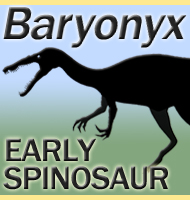 |
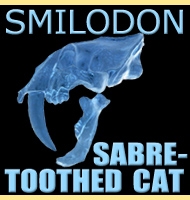 |
 |
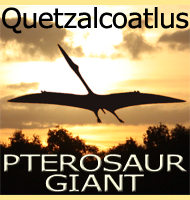 |

